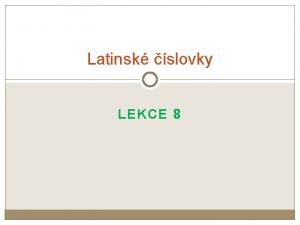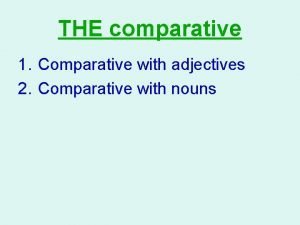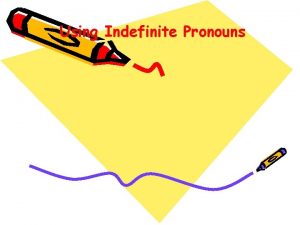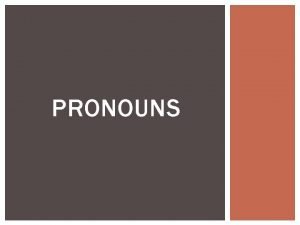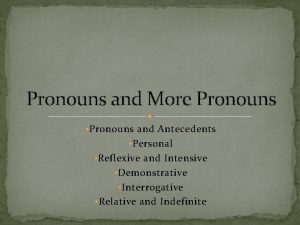Pronouns and UNUS NAUTA Adjectives Week 5 Review














- Slides: 14

Pronouns and UNUS NAUTA Adjectives Week 5 Review

Pronouns � In Latin, just as in English, Pronouns stand in the place of nouns. � Pronouns in Latin have 3 characteristics: gender, number, and case. � Latin pronouns decline similar to nouns to exhibit their gender, number, and case. � Most Latin pronouns roughly follow the 2 -1 -2 declension pattern, but they also use unique genitive (-ius) and dative singular (-i) endings. ◦ I like to think of this as a separate “Pronoun Declension” that uses 2 -12 declension endings with the addition of the gen. (-ius) and dative sing. (-i). � The gender and number of pronouns agree the with the nouns that they replace. The case of pronouns will change based upon their syntactical use in a sentence. � Most pronouns in Latin can also be used as adjectives, if they modify a noun that is present instead of simply replacing it.

Demonstrative Pronouns (and Adj. ) � The Demonstrative pronouns (can also be adjectives) are used to ‘point’ to things – “this”, “that”, “these”, “those”. � They follow the standard pronoun decl. pattern (2 -1 -2 + -ius, -i) ille, illa, illud – “that”, “those” Neut. Masc. (sing. ) Fem. illud ille NOM. illa illīus GEN. illīus illī DAT. illī illud illum ACC. illam illō ABL. illā (plur. ) illa NOM. illī illae illōrum GEN. illōrum illārum illīs DAT. illīs illa ACC. illōs illās illīs ABL. illīs Summary of Endings: -e / -a / -ud -īus / -īus -ī / -ī -um /-am/-ud -ō / -ā / -ō -ī / -ae / -a -ōrum /-ārum /-ōrum -īs / -īs -ōs / -ās / -a -īs / -īs

Demonstrative Pronouns (and Adj. ) � The demonstrative pronoun (and adjective) iste, ista, istud is used to ‘point’ to things with a distinctly negative connotation. � It follows the pronoun decl. pattern (2 -1 -2 + -ius, -i) like ille exactly. iste, ista, istlud – “that”, “those”, “that (grr!)…” Neut. Masc. (sing. ) Fem. Summary of Endings: istud iste NOM. ista -e / -a / -ud istīus GEN. istīus -īus / -īus istī DAT. istī -ī / -ī istud istum ACC. istam -um /-am/-ud istō ABL. istā -ō / -ā / -ō (plur. ) ista NOM. istī istae -ī / -ae / -a istōrum -ōrum /-ārum /-ōrum GEN. istōrum istārum istīs DAT. istīs -īs / -īs ista ACC. istōs istās -ōs / -ās / -a istīs ABL. istīs -īs / -īs

Demonstrative Pronouns (and Adj. ) The Demonstrative pronoun hic, haec, hoc (“this”, “these”) combines the stem “h-” + ending + “-c” (a deictic marker used for pointing) in some cases. � When this “-c” marker runs up against certain endings like “-a” or “-m” various linguistic changes will happen. [“-a” + “-c” -> “-aec” ; “-m” + “-c” -> “-nc”] � Otherwise, it follows the standard pronoun decl. pattern (2 -1 -2 + -ius, -i) � hic, haec, hoc – “this”, “these” Neut. Masc. (sing. ) Fem. hoc hic NOM. haec huīus GEN. huīus huīc DAT. huīc hoc hunc ACC. hanc hōc ABL. hāc (plur. ) haec NOM. hī hae hōrum GEN. hōrum hārum hīs DAT. hīs haec ACC. hōs hās hīs ABL. hīs Summary of Endings: Ø / -a / Ø -īus / -īus -ī / -ī -um /-am/ Ø -ō / -ā / -ō -ī / -ae / -a -ōrum /-ārum /-ōrum -īs / -īs -ōs / -ās / -a -īs / -īs

Demonstrative Pronouns (and Adj. ) The Demonstrative pronoun and adjective is, ea, id (“this”, “these”, etc. ) serves as both demonstrative and the 3 rd personal pronoun (“he”, “she”, “it”, “they”) � The stem is really an “i-”, but it will weaken to an “e-” up against most vowels, hence the stem here looks like it’s an “e-” because of all the vowels in the endings. � is, ea, id – “this”, “that”, “these”, “he”, “she”, “it”, “they”, etc. (sing. ) NOM. GEN. DAT. ACC. ABL. (plur. ) NOM. GEN. DAT. ACC. ABL. Masc. is eīus eī eum eō Fem. ea eīus eī eam eā Neut. id eīus eī id eō Summary of Endings: eī, iī eōrum eīs eōs eīs eae eārum eīs eās eīs ea eōrum eīs ea eīs -ī / -ae / -a -ōrum /-ārum /-ōrum -īs / -īs -ōs / -ās / -a -īs / -īs Ø / -a / Ø -īus / -īus -ī / -ī -um /-am/ Ø -ō / -ā / -ō

Demonstrative Pronouns (and Adj. ) The Demonstrative pronoun and adjective īdem, eadem, idem (“the same”) is a combination of is, ea, id + “-dem” (another deictic marker) � When the “-dem” comes up against an “-m”, it will produce “-ndem”; similarly, the “s” in “is” will drop and the short “i” will lengthen to compensate -> īdem � īdem, eadem, idem – “the same” Neut. Masc. (sing. ) Fem. idem īdem NOM. eadem eīusdem GEN. eīdem DAT. eīdem idem eundem ACC. eandem eōdem ABL. eādem (plur. ) eadem NOM. eīdem eaedem eōrundem eārundem eōrundem GEN. eīsdem DAT. eadem eōsdem eāsdem ACC. eīsdem ABL. Summary of Endings: Ø / -a / Ø -īus / -īus -ī / -ī -um /-am/ Ø -ō / -ā / -ō -ī / -ae / -a -ōrum /-ārum /-ōrum -īs / -īs -ōs / -ās / -a -īs / -īs

Intensive Pronoun The Intensive pronoun ipse, ipsa, ipsum (“___self”) strengthens whatever it modifies. � Thus, when it modifies some 3 rd person item, it will translate as “himself”, “herself”, “itself”, “themselves”; if it modifies a 1 st person item it will be: “myself”, “ourselves”; if it modifies a second person item it will be: “yourself”, “yourselves”. � It follows the standard pronoun decl. pattern (2 -1 -2 + -ius, -i) like ille, illa, illud � ipse, ipsa, ipsum – “____self” Masc. (sing. ) Fem. ipse NOM. ipsa ipsīus GEN. ipsīus ipsī DAT. ipsī ipsum ACC. ipsam ipsō ABL. ipsā (plur. ) NOM. ipsī ipsae GEN. ipsōrum ipsārum DAT. ipsīs ACC. ipsōs ipsās ABL. ipsīs Neut. ipsum ipsīus ipsī ipsum ipsō Summary of Endings: ipsa ipsōrum ipsīs ipsa ipsīs -ī / -ae / -a -ōrum /-ārum /-ōrum -īs / -īs -ōs / -ās / -a -īs / -īs -e / -a / -um -īus / -īus -ī / -ī -um /-am/-um -ō / -ā / -ō

Personal Pronouns The personal pronouns stand in place of people (“I”, “me”, “you”, “we”, “us”, “y’all”, etc. ) � As noted above, the demonstrative is, ea, id is used for the third personal pronoun; here we’ll cover only the 1 st and 2 nd personal pronouns. � ego, meī – “I”, “me” tū, tuī – “you” nos, nostrum – “we”, “us” vōs, vestrum – “you (pl. )”, “y’all” 1 st Person (sing. ) 2 nd Person ego NOM. tū meī GEN. tuī mihi DAT. tibi mē ACC. tē mē ABL. tē (plur. ) NOM. nōs vōs GEN. nostrum/nostrī vestrum/vestrī DAT. nobis vobis ACC. nōs vōs ABL. nobis vobis

Reflexive Pronouns Reflexive pronouns stand in place of nouns, but ALWAYS refer back to the SUBJECT of the sentence. � As such, they only exist in the oblique cases (i. e. , all cases other than the nom. ) � For the 1 st and 2 nd pers. reflexive pron. , the same forms as the personal pronouns are used. � For the 3 rd person reflexive pronouns, a new pronoun (“suī, sibi, sē”) is used. � (sing. ) NOM. GEN. DAT. ACC. ABL. (plur. ) NOM. GEN. DAT. ACC. ABL. 1 st Person --meī mihi mē mē 2 nd Person --tuī tibi tē tē 3 rd Person ---suī sibi sē sē --nostrī nōbīs --vestrī vōbīs --suī sibi sē sē

Relative Pronoun The Relative pronoun quī, quae, quod (“who”, “which”, “that”) begins a new clause that relates back to an item in another clause in the sentence. � The relative pron. will take the gender and number of the noun it relates back to, while the relative pron. will have its own case, based on its syntactical use in the relative clause. � The relative pronoun is also used as the interrogative adjective (“who”, “what”) � quī, quae, quod – “who”, “which”, “that” Neut. Masc. (sing. ) Fem. Summary of Endings: quod quī NOM. quae -ī / -ae / -od cuius GEN. cuius -ius / -ius cui DAT. cui -i / -i quod quem ACC. quam -em /-am/ -od quō ABL. quā -ō / -ā / -ō (plur. ) quae NOM. quī quae -ī / -ae quōrum -ōrum /-ārum /-ōrum GEN. quōrum quārum quibus -ibus / -ibus DAT. quibus quae ACC. quōs quās -ōs / -ās / -ae quibus -ibus / -ibus ABL. quibus

Interrogative Pronoun The Interrogative pronoun quis, quid (“who”, “whose”, “whom”, “what”, “which”) asks for the identity of a person or thing. � The masculine and feminine singular forms are the same in the singular. � The plural forms of the interrogative pronoun are identical to the relative pronoun � quis, quid – “who”, “whose”, “whom”, “what”, “which” (sing. ) NOM. GEN. DAT. ACC. ABL. (plur. ) NOM. GEN. DAT. ACC. ABL. Masc. quis cuius cui quem quō Fem. quis cuius cui quem quō Neut. quid cuius cui quid quō Summary of Endings: quī quōrum quibus quōs quibus quae quārum quibus quās quibus quae quōrum quibus quae quibus -ī / -ae -ōrum /-ārum /-ōrum -ibus / -ibus -ōs / -ās / -ae -ibus / -ibus -is / -id -ius / -ius -i / -i -em /-em/ -id -ō / -ā / -ō

UNUS NAUTA Adjectives �A special set of adjectives (often called UNUS NAUTA) follow the pronoun declension pattern: mostly like 2 -1 -2 adjectives, but they use an “-ius” gen. sing. and an “-i” dat. sing. endings like the pronouns. � Other than having irregular forms, they function as normal adjectives. � UNUS NAUTA is an acronymic mnemonic device to help you remember these 9 adjectives: You will definitely want to learn to U ◦ ūnus, -a, -um recognize these adjectives when you N ◦ nūllus, -a, -um see them to help you remember the U ◦ ūllus, -a, -um irregular forms. S ◦ sōlus, -a, -um N A U T A ◦ ◦ ◦ neuter, neutra, neutrum alius, -a, -ud uter, utra, utrum tōtus, -a, -um alter, altera, alterum The next slide will allow you to practice declining one of these adjectives, but note that you should be able to decline them all following the same pattern.

UNUS NAUTA Adjectives �A special set of adjectives (often called UNUS NAUTA) follow the pronoun declension pattern: mostly 2 -1 -2, but use an “-ius” gen. sing. and an “-i” dat. sing. � Other than the irregular forms, they function as normal adjectives. sōlus, -a, -um – “alone”, “only” (sing. ) NOM. GEN. DAT. ACC. ABL. (plur. ) NOM. GEN. DAT. ACC. ABL. Masc. sōlus sōlī sōlum sōlō Fem. sōla sōlīus sōlī sōlam sōlā Neut. sōlum sōlīus sōlī sōlum sōlō Summary of Endings: sōlī sōlōrum sōlīs sōlōs sōlīs sōlae sōlārum sōlīs sōlās sōlīs sōla sōlōrum sōlīs sōla sōlīs -ī / -ae / -a -ōrum /-ārum /-ōrum -īs / -īs -ōs / -ās / -a -īs / -īs -us / -a / -um -īus / -īus -ī / -ī -um /-am/-um -ō / -ā / -ō
 Unus nauta
Unus nauta Druhova cislovka
Druhova cislovka Unus duo tres nihil
Unus duo tres nihil Latinské číslovky na recepte
Latinské číslovky na recepte Numeri in latino fino a 1000
Numeri in latino fino a 1000 Nauta
Nauta Palabras con prefijo quinqu
Palabras con prefijo quinqu Maarten nauta
Maarten nauta Week by week plans for documenting children's development
Week by week plans for documenting children's development Adjective comparative superlative
Adjective comparative superlative Normal and strong adjectives
Normal and strong adjectives Indefinite adjectives examples
Indefinite adjectives examples He is dreaming (george)
He is dreaming (george) Circle the demonstrative pronoun in each sentence
Circle the demonstrative pronoun in each sentence Pronouns demonstrative english
Pronouns demonstrative english



